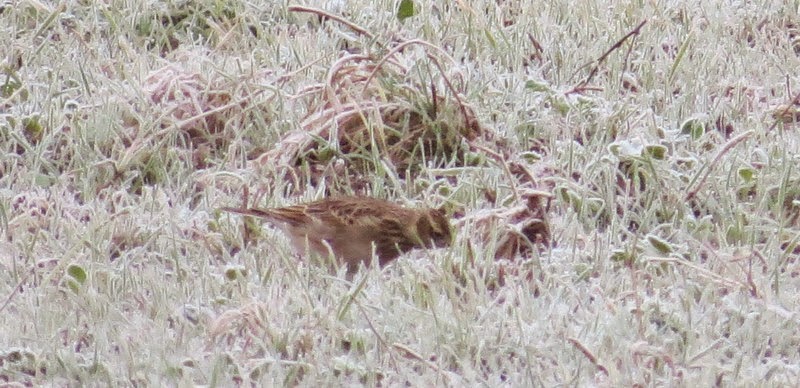Today was a good day. It began very cold (sub-zero) with a thick layer of frost, all water-courses frozen, and a layer of cloud which meant the temperature would only rise slowly.
A Chaffinch on a frosty branch sets the scene well.
I wasn't sure whether Dave would be joining me so I decided to head through the village and along the road below Bannams Wood. By the time I reached the wood it was clear I would be on my own today, and I soon found a co-operative party of small birds. These included a Treecreeper, and a Coal Tit which I managed to add as my last photo year-tick.
 |
| 101. Coal Tit |
Also in the party were at least six Long-tailed Tits, a Marsh Tit, and a Goldcrest. Sadly the latter just wouldn't play ball and remained as the one that got away as far as a photograph is concerned.
At the end of the wood I turned to head towards the frozen pools. A familiar shape was perched on the pylon above me.
 |
| Peregrine |
The adult Peregrine was my first bird of prey today, and it was not to be my last. At the bottom of the slope I checked the Owl tree and sure enough it was back in residence.
 |
| Tawny Owl |
I reached the gap and scanned for the Stonechats. There was no sign of them, but instead I found something a lot better.
 |
| Barn Owl |
The Barn Owl was sitting in an ivy-clad pollarded willow on the far side of the field. I cranked the camera up to maximum magnification to take some shots. I could have got closer, but at some point I would have flushed it and I prefer not to do that. It stretched its wing and looked around, but seemed pretty content. Only my second sighting here this year.
A little further on I could hear a Kestrel calling. I could feel a theme coming on. Raptor day.
 |
| Kestrel |
There were actually two, which is no doubt why one of them was calling. The flashes contained not only ice, but also a ramshackle canvas shooting hide, several decoy ducks, and one or two ex-Mallards. Obviously yesterday had been the day to avoid.
About 30 Skylarks swarmed across the field ridge, and I chose to walk through the little wood. This added nothing to the day, but back at the dragonfly pools corvid calls led me to the pale Buzzard which had alighted on a hedge.
 |
| Common Buzzard |
It suddenly looked round and appeared anxious...and then there were two.
Shortly afterwards the sun came out and I was tempted to stroll to the little pond to see if I could add anything more. About 30 Yellowhammers and a few Chaffinches were feeding on the track, and as I left the area half a dozen Lesser Redpolls appeared.
 |
| Lesser Redpoll |
I felt it was about time I had a good day here. Looking back, the year has been a game of two halves. The first four months producing rarities like a flock of Bewick's Swans, a Green-winged Teal and a pair of Avocets before the middle of April. Then the going got tougher, a Grasshopper Warbler sang but remained largely unseen for several weeks, a couple of sightings of juvenile Ruffs in August, and after a Yellow-crowned Weaver gave us the runaround in September, a Marsh Harrier flew through while I sat at home researching the weaver. It was to be one of those autumns, a real slog with few highlights.
But 2015 will be another year. Let the fun begin.

















































